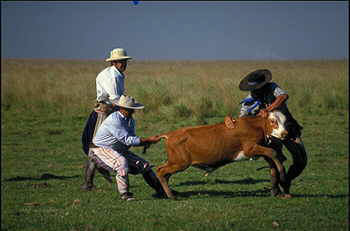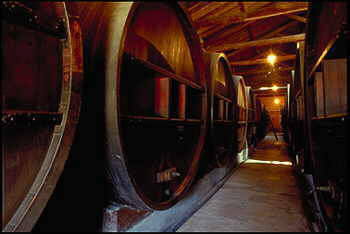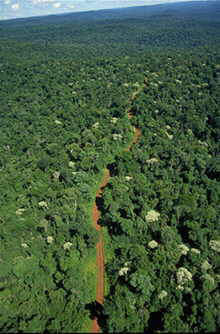 ARGENTINA - BREADBASKET OF THE WORLD ARGENTINA - BREADBASKET OF THE WORLD |
For nearly a century, Argentina has been known as the breadbasket of the world. And although its profile has been changing dramatically over the past few years as other areas of the economy also expanded, the country remains to this day a major producer and exporter of grains, oilseeds and beef.
For example, soybean crops are hitting a record high this season, while the wheat plantation area is also growing substantially. This has a major impact on world markets, as Argentina exports 90 percent of its grain output.
And while agriculture contributes with only 5 percent of the country’s $280 billion Gross Domestic Product (GDP), it makes up a much larger chunk of its exports: a whopping 40 percent of the nation’s $23 billion in foreign sales.
Exports of soybean and its byproducts alone are expected to bring in this season between $1.3 billion to $2 billion -depending on pricing, weather conditions and other variables. This was made possible by a combination of two major factors: a recent rebound in international prices and a 25 percent increase in Argentina’s soybean plantation area.
The wheat planting area also rose significantly, by 10 percent, reaching 7.1 million hectares.
All this took place under very unfavorable conditions mostly caused by protectionism by some of the most powerful nations in the world, Argentine government officials and producers complain.

We are supposed to compete, survive and grow with producers that in the United States receive 20 percent of their income through subsidies, 40 percent in Europe and 60 percent or more in Japan, protests Agriculture Secretary Marcelo Regunaga.
Hector Marsili, President of major grain producer Cargill -a U.S. company established in Argentina more than half a century ago and which currently has 1,800 employees in the country--, says adversity is a problem, but not an insurmountable one.
I think that our agricultural sector is so powerful and competitive that we continue growing even in those circumstances, he says. Argentine producers are quick, flexible and incorporate new technologies to their work at low costs.”
Argentina is also a major producer of maize and other grains, oilseeds and livestock products. But its world-acclaimed steak took a serious hit due to an outbreak of the crippling foot-and-mouth disease.
 Gaucho cowboys sing the blues Gaucho cowboys sing the blues |
Amid much fanfare, fresh Argentine meat was shipped to the lucrative American market in 1997 for the first time in over 60 years after the country was declared free of the infection. Two years later, Argentina fully filled the U.S. import quota of 20,000 tons of prime cuts.
Other countries followed suit wiring their orders and soon enough demand for Argentine beef went through the roof, showering millions of dollars on local ranchers who had been boosting their livestock headcount in anticipation of the move.
However, the fiesta didn’t last long: disaster struck in August 2000, when first the United States and then other nations suspended fresh meat orders after some Argentine cattle were discovered to have anti-bodies for the disease - a sign that the virus had not been totally eradicated.
An outbreak of the infection in Europe made matters even worse, as global sensitivity over the issue rose dramatically and foot-and-mouth, a term only known to those in the meat industry, soon became a household term. Add the mad-cow scare and a weak euro, and the result is a dark scenario.
In the early nineties Argentina was one of the countries that did the most to control food diseases. We have to promote this, because the European people are very sensitive about it nowadays, Regunaga says.
This situation dealt a hard blow to Argentine cattle breeders, with some meatpacking plants closing down. However, the impact was cushioned to a good extent by one major factor - with 68 kilos per person a year, Argentines are the world’s biggest beefeaters, gulping down 85 percent of the domestic production. Anyone who’s ever partaken of an Argentine asado (barbecue) knows what this is all about.

And yet, what is bad for some is good for others - part of the increase in the planted soybean and wheat surface is due to the conversion of cattle grazing lands into crop areas.
A similar case occurred across the Atlantic, as European demand for Argentine soybean rose dramatically after another disaster, the mad-cow disease, led farmers to substitute animal flour with soybean flour --which has a high protein content—to use as fodder.
Actually, the world demand for soybean is so strong that a recent U.S. Department of Agriculture report showed that while all four major soybean producers -Argentina, Brazil, China and the United States—are increasing their output, the overall grain’s stocks shrank by one million tons.
 Argentine chickens fly high Argentine chickens fly high |
At the same time, the relatively young poultry industry is experiencing quick expansion. Argentina exports only 20,000 tons a year of bird meat, but the Poultry Processing Companies Center (CEPA) reckons that the figure could grow tenfold within just a few years without much difficulty.
The latest official figures show that poultry foreign sales over the first quarter of 2001 rose by 29 percent in volume and by 33 percent in dollar terms.
Just like what happened with grains, bird meat demand, particularly in Europe, has been on a constant rise. The European Union is expected to take an extra 2,000 tons this year and plans are under way to increase sales to the Middle East and Asia.
The country’s industry is recovering from a couple of bad years, during which their activities were badly hurt by cheap Brazilian imports. But after the government determined that the neighboring country was incurring in dumping activities, it clamped countervailing duties on poultry imports, bringing a respite to local producers.
Now local chicken farmers celebrate Poultry Day on July 24, to mark the day last year when the government finally listened to their complaints and slapped compensation duties on Brazilian chicken imports.
According to the Argentine Chamber of Poultry Producers, the industry, which employs 132,000 people, could given the right conditions grow by 10 percent a year within the next three years.
 Argentina protects its fish reserves Argentina protects its fish reserves |
With plenty of highly coveted hake in its territorial waters and a population that favors red meat over pretty much everything else, Argentina witnessed a dramatic growth in fish exports over the past few years, bringing in $1 billion in foreign sales in 1997.
But too much of a good thing is no good, and soon the country found out that overfishing was depleting hake’s reserves. So it immediately clamped a ban on fish catches, a move that was later on substituted with severe restrictions on hake capture.
We needed to create a conservation strategy in order to control our natural resources, explains Secretary Regunaga.
| Jose Luis Lizurume, governor of the southern province of Chubut, says that during the previous administration of President Carlos Menem hake catches were absolutely out of control.”
Authorities recently allowed fishermen to nearly double their catch of the hubbsi subspecies to 210,000 tons a year from the current 110,000 after a series of studies proved a healthy growth in the size of fish schools. Now authorities reckon that with those limits, hake can recover its historic levels within the next two years.
The improvement in reserves is now attracting new investment to a sector of the economy that was badly hurt by the forced restrictions.
In May, South Africa’s Irvin & Johnson purchased Argentina’s fishing company Alpesca for $60 million from the Argentina textile and footwear company Alpargatas and announced plans to invest an extra $40 million to build a state-of-the-art freezing and packing plant.
Based in Puerto Madryn, Alpesca is one of Argentina’s largest fishing companies with $24 million in annual sales, most of it to Europe. The new owners plan to increase Alpesca’s workforce from the current 400 to 1,200 employees.
Other major fishing firms include Patagonian Longlining, Spain’s Arbumasa, Explotación Pesquera de la Patagonia and Frigorífico Sud Este.
 "La vie couleur du vin" "La vie couleur du vin" |

Argentina’s wine industry is also undergoing dramatic changes -having attracted some $500 million in foreign investments, it is quickly substituting traditional vines with high-quality grapes and conquering new markets every day.
Given the massive injection of foreign capital, only a handful of the more than 1,000 registered cellars now remain in the hands of their original owners.
Most of the funds go to the sector’s modernization. We invested more than $500 million in machinery during the last ten years in order to improve wine production, says Eduardo Garat, president of the Argentine Wineries Association.
He estimates that wine exports, currently worth around $100 million, could double in four or five years time as more and better wines are being produced every year.
For example, Argentina’s Trapiche cellar was recently named Best International Winery by Vinitaly 2001 Fair in Verona, Italy. Established in 1883 in Mendoza, Trapiche is one of Argentina’s top premium wine exporters, with more than six million bottles sold last year to 40 nations.
Foreign investors include a group led by the legendary French wine maker Michel Rolland, who earlier this year decided to invest $50 million to set up a cellar in Mendoza. The new company, Vitiflor, is planting malbec, cabernet sauvignon, merlot and chardonnay varieties in a bid to produce high-quality wines for export, mostly to France.
Also, Britain’s Allied Domecq, the world’s second largest spirits and winemaker, recently purchased Argentine wineries Graffigna and Santa Silvia -in the provinces of San Juan and Mendoza respectively-- for a total $43 million.
 Foodstuff heavyweights Foodstuff heavyweights |
Argentina is also the world’s top producer of honey, lemons (San Miguel SA, in the northern province of Tucuman, is the single largest producer and exporter of lemons in the world) and many other staples, so it should come as no surprise that some of the country’s most solid and dynamic companies are on the foodstuff business.
Confectioners Arcor, dairy Mastellone and flour and cooking oil producer Molinos are cases in point: together, they post $2.3 billion a year in sales, including nearly $500 million in overseas shipments.
They were not immune to the worst recession in a decade, but by lowering prices, keeping costs under control, introducing new products that closely follow consumers’ tastes and embarking on aggressive export drives, they were able to more than hold their own.
Cost cutting is another tool companies are resorting to in order to maximize efficiency in difficult times. Molinos recently got rid of several money-losing business areas and discontinued brands that were not at the top of the charts. The company is also moving away from bulk food production such as grains in favor of more value-added items.
Keeping consumers’ changing habits in mind, Mastellone has been increasing its output of low-calorie and low-cholesterol products. This approach not only helps domestic sales but also improves the company’s export profile.
With the French Commerce Ministry on the record as saying that over the next decade Argentina will become one of the world’s leading suppliers of dairy products, having a complete line of health-food products readily available is definitely a wise decision.
Other major dairy producers include SanCor, Milkaut, Danone, Parmalat, Nestle, Kasdorf and Cabana Santa Rosa.
Export markets are not unchartered ground for Arcor, the world’s top producer of hard sweets. Last year it sold $217 million worth of sweets, chocolates and cookies to more than 100 foreign countries, including China, where it has a solid distribution chain that ensures the presence of its products in kiosks in 40 different cities.
And a recent deal with the U.S. Brach’s Confections to produce 25,000 tons of sweets and chocolate-coated candies for sale in America should help double sales to the world’s number one economy, to around $60 million a year.
 Forestry also on the rise Forestry also on the rise |

A recent study issued by the Agriculture Secretariat revealed that the booming forestry industry is doing better than expected, having reached one million hectares of woodland -- a 25 percent increase over a decade ago.
The industry has attracted $2.6 billion in investments since 1992 from Argentine, Chilean, American, German and Swiss companies and is expected to attract an extra $4 billion over the next five years, generating $1.2 billion in exports and creating hundreds of thousands of new jobs.
Both producers and the government agree that the expansion can lead Argentina from being a net wood and paper importer to exporter within the next decade.
The recent passing of a law introducing a series of incentives, such as Value Added Tax refunds, lower freight rates, softer financing terms and a pledge not to increase taxes for 30 years is expected to add momentum to the industry.
Major players include Ledesma (which on top of making printing and writing paper is also a major producer of sugar, alcohol, and citrus fruits), Pecom Forestal, of the Perez Companc Group, and Chile’s Papelera del Plata, Alto Parana and Masisa. |

